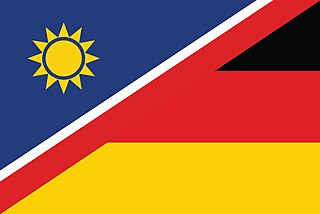| History of Namibia |
|---|
 |
The following is a timeline of the history of the city of Windhoek, Namibia.
| History of Namibia |
|---|
 |
The following is a timeline of the history of the city of Windhoek, Namibia.
| | This section needs expansion. You can help by adding to it. (August 2017) |
| | This section needs expansion. You can help by adding to it. (August 2017) |

Windhoek is the capital and largest city of Namibia. It is located in central Namibia in the Khomas Highland plateau area, at around 1,700 m (5,600 ft) above sea level, almost exactly at the country's geographical centre. The population of Windhoek in 2020 was 431,000 which is growing continually due to a continued migration from other regions in Namibia.
Dirk Frederik Mudge was a Namibian politician. He served in several high-ranking positions in the South African administration of South West Africa, was the chairman of the 1975–1977 Turnhalle Constitutional Conference, and co-founded the Republican Party (RP) of Namibia as well as the Democratic Turnhalle Alliance (DTA), now known as the Popular Democratic Movement (PDM).

German Namibians are a community of people descended from ethnic German colonists who settled in present-day Namibia. In 1883, the German trader Adolf Lüderitz bought what would become the southern coast of Namibia from Josef Frederiks II, a chief of the local Oorlam people, and founded the city of Lüderitz. The German government, eager to gain overseas possessions, annexed the territory soon after, proclaiming it German South West Africa. Small numbers of Germans subsequently immigrated there, many coming as soldiers, traders, diamond miners, or colonial officials. In 1915, during the course of World War I, Germany lost its colonial possessions, including South West Africa ; after the war, the former German colony was administered as a South African mandate. The German settlers were allowed to remain and, until independence in 1990, German remained an official language of the territory alongside Afrikaans and English.

White Namibians are people of European descent settled in Namibia. The majority of White Namibians are Afrikaners, with many of the White minority being German Namibians. Many are also Portuguese or English immigrants. Estimates published in 2016 suggest that the White Namibian population run between 75,000 and 150,000. This imprecision in data is because the Namibian government no longer collects data based on race.

The Turnhalle Constitutional Conference was a conference held in Windhoek between 1975 and 1977, tasked with the development of a constitution for a self-governed South West Africa (Namibia) under South African control. Sponsored by the South African government, the Turnhalle Conference laid the framework for the government of South West Africa from 1977 to independence in 1989.

Wilhelm Sander was a master architect and contractor working for Sander & Kock known for his work in German South West Africa, today's Namibia.
The following is a timeline of the history of Cape Town in the Western Cape province of South Africa.
The following is a timeline of the history of the city of Kampala, Buganda, Uganda.
The following is a timeline of the history of the city of Johannesburg, in the Gauteng province of South Africa.
The following is a timeline of the history of the city of Gaborone, Botswana.
The following is a timeline of the history of the city of Bamako, Mali.
The following is a timeline of the history of the city of Niamey, Niger.
The following is a timeline of the history of the city of Libreville, Gabon.
Mass media in Namibia includes radio, television, and online and print formats.
The following is a timeline of the history of the city of Monrovia, Liberia.
The following is a timeline of the history of the city of Bujumbura, Burundi.
The following is a timeline of the history of the city of Port Louis on the island of Mauritius.
The following is a timeline of the history of the city of Durban in the eThekwini Metropolitan Municipality, KwaZulu-Natal province, South Africa.
The following is a timeline of the history of Port Elizabeth in the Nelson Mandela Bay Municipality, Eastern Cape province, South Africa.
The following is a timeline of the history of the city of Kigali, Rwanda.
Windhuk
South West Africa
{{cite book}}: |author= has generic name (help)This article incorporates information from the Afrikaans Wikipedia and German Wikipedia.
Windhoek. via Google Books